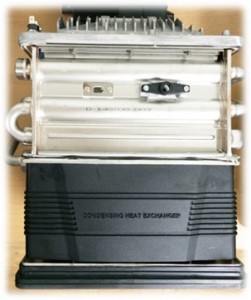 Maintenance Of A Stainless Steel Heat Exchanger: Do’s and Don’ts
Maintenance Of A Stainless Steel Heat Exchanger: Do’s and Don’ts
The stainless steel heat exchanger is a critical component of any Noritz condensing tankless water heater. In general, heat exchangers transfer heat from one medium to another through convection. For condensing units, the stainless steel heat exchanger transfers heat energy from the exhaust gasses leaving the water heater into the water.
Note: A second heat exchanger in all Noritz condensing units, made of copper, transfers heat energy from the gas burner to the water.
Stainless steel heat exchangers are, therefore, largely responsible for a condensing unit’s superior energy efficiency. Without them, the exhaust heat could not be recycled, permitting the system to capture more energy from the combustion process (resulting in a higher efficiency rating).
That’s why it is crucial that homeowners and their service contractors each play their part in maximizing exchanger life.
What Not to Do
Sometimes, in trying to fix one problem in a tankless water heater, the service technician can inadvertently create another by mishandling the stainless steel heat exchanger.
Be gentle when removing the exchanger. Do not grab it by the pipe headers, as this will bend and weaken the pipe, which can leak or crack in the future. In general, do not handle it like a piece of scrap metal.
A cracked heat exchanger pipe will eventually cause dripping and puddles to form underneath the heater. It can also cause an Error Code 11, which indicates ignition failure, according to Sam Barba, Field Service & Sales Engineer at Noritz. Check out more info on common error codes here.
Although it should last at least 10 years, a stainless steel heat exchanger will fail sooner if the homeowner never services or descales the unit. Do not be neglectful.
What To Do
Instead of grabbing the heat exchanger by the pipe headers, hold it by the side. This will prevent the pipe from being damaged and causing pinhole leaks.
When reinstalling the copper heat exchanger to the stainless steel heat exchanger, add some silicone lubricant to the inside of the stainless steel pipe and to the O-rings to facilitate the assembly.
It’s important to note that the same care should be taken with the unit’s copper heat exchanger, although copper is more flexible and will be slightly more resilient.
Homeowners and builders should invest in a water softener or water filtration system that will cut down on scale accumulation, in turn preventing long-term damage to the heat exchanger. Service and descale the water heater every year or two, especially if you live in a hard water area. See how to descale a tankless water heater.
For more information, contact Noritz at 714-433-2905 or visit https://www.noritz.com/